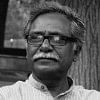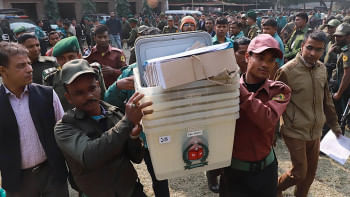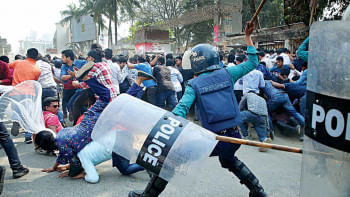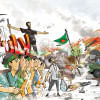Is there a Left left in Bangladesh?

How should we define the left and leftist agenda? What goals and ideologies does the left typically hold? The left envisions a society in which everyone has equal dignity, equal rights, and equal access to opportunities. They aim for an ecosystem where humans can live in harmony with nature and without causing harm. To achieve this, one must stand against corporate capitalism, imperialism, racism, and communalism. The left fights against any and all forms of oppression and believes that as long as the state is in the hands of the imperialist or capitalist class, true emancipation is not possible. The left's agenda is global, not just national.
In recent years, the environment has been playing an increasingly important role in the leftist vision. For-profit development approach and private capital accumulation not only harm human life, but also put the existence of human civilisation at risk. Armaments, war, and various forms of pollution—such as plastic, chemical, electronic, and nuclear waste—have an extremely negative impact on the world. The left stands against all such destructive forces.
Contrary to the claim of right-wing advocates that the left's agenda diminished with the end of the Soviet Union, it actually entered a new phase without a centre like Moscow or Beijing. Globally, the broad left is adapting to new challenges—fighting increasing environmental destruction, inequality, hatred of the "other," and war. The recent protests against climate change and against Israel's aggression on Palestine—involving millions of people worldwide—align with a largely leftist agenda, even if individual motivations vary. The anti-capitalist voices of mainstream figures like Jeremy Corbyn in the UK and Bernie Sanders in the US are the outcome of the global capitalist crisis and people's aspiration for a new world.
In some European countries, left-leaning parties have come to power and established agendas that include healthcare for all, education for all, gender equality, disability benefits, and special opportunities for children. The left also takes an anti-war stance and, particularly in Europe, welcomes immigrants and refugees. Conversely, many European countries currently have strong right-wing parties that promote anti-immigrant notions, corporate grabbing, and threat of permanent war—making life increasingly difficult for people at large. In Latin America, the left holds a strong anti-imperialist position. Countries like Cuba, Venezuela, Bolivia, and Brazil oppose the decades-long US imperialist horror in Latin America. Globally, protests against wars and imperialist domination—whether in Asia, Africa or Latin America; whether in Iraq, Afghanistan, Syria or Palestine—are mainly organised by the left.
Now, how is the left doing in Bangladesh? Compared to other examples, leftist parties in Bangladesh are in a weak condition, and both internal and external factors come into play here. During the 1950s and 1960s, the left gained prominence in this region, playing a key role in the Language Movement of 1952 and in the Mass Uprising of 1969. Back then, the left also had unparalleled influence over peasant and worker mobilisations. However, the left's influence waned after the 1960s, partly due to the conflict between China and the Soviet Union. The left in Bangladesh was divided based on their allegiance to either Moscow or Beijing, and a significant portion of the Peking-leaning groups abandoned mass organisations due to the influence of the Naxalite movement. This spelled disaster.
Leftist parties in general participated strongly in the 1971 Liberation War. But internal divisions emerged within a few groups due to China's influence, which adversely affected the entire left. From 1972 to 1975, some leftist groups aligned with the government, while others faced constant persecution. Thousands of leftist workers were killed, and organisational spaces like trade unions and student unions became sites of violence—a trend which continued during the military rule.
By the time the Soviet Union fell, leftist ideologies had suffered setbacks globally. Internally, the left in Bangladesh lacked confidence for years, relying on external support from Moscow or Beijing. There was a lack of focus on self-identity, so instead of unifying, the left in the 1980s put their strength and efforts behind either Sheikh Hasina-led Awami League or Khaleda Zia-led BNP, prioritising their agendas over the left's own.
In fact, throughout Bangladesh's history, rulers—from Sheikh Mujibur Rahman to Ziaur Rahman, HM Ershad, Khaleda Zia, and Sheikh Hasina—have been able to get unconditional support from one or another leftist party. This resulted in the liquidation of many leaders into the ruling class' parties. Consequently, a significant number of "ex-left" individuals have emerged as working for the Awami League or BNP or Jatiya Party. Nowadays, the portion of the ex-left is probably larger than that of the functioning left.
When discussing leftist parties, it is essential to examine the agendas they work for, rather than focusing on symbolic elements like banners or posters. Are they standing against discrimination in all forms? Are they against imperialism? Are they fighting for the conservation of nature and the planet? Are they organising people for a new vision and for emancipation? Are they seriously addressing questions of class, along with gender and ethnicity issues?
Unfortunately, the current answer to all these questions for many of the parties known as the left in Bangladesh is "no." Some parties are known as being leftist, but boast banners and symbols aligned with the current government and associated with its anti-people policies, autocratic rule, and profit-driven destruction and corruption under the guise of "development." Those supporting the capitalist agenda, regardless of their banners and logos, cannot be considered as the left. The lack of focus on building an alternative vision for the people, the periodic surrender or betrayal of some left leaders in favour of right-wing forces, and the strong wave of neoliberal thinking have had devastating effects on the rise of people's power. A historical failure in identifying their own faults and being self-critical added to the crisis of the left in Bangladesh.
Despite the shortcomings of organised leftist parties in Bangladesh, the left agenda resonates with the interest of the majority, offering ample space for a truly pro-people, pro-humanity, and pro-environment future. When dividing overall development ideologies into two categories, with the left being pro-people and the right being pro-capital, the direction towards which the global society should lean becomes evident. The present crisis of democracy, the rise of reactionary forces, increasing state violence and war, alongside rising inequality, climate crisis, surveillance, and disaster capitalism all indicate the urgent need for reinventing, reorganising, and strengthening the left forces in Bangladesh and worldwide. An essential condition for this would be to stand for an independent identity and a clear and determined vision, mixed with creative politics.
As told to Monorom Polok of The Daily Star.
Anu Muhammad is former professor of economics at Jahangirnagar University.
Views expressed in this article are the author's own.
Follow The Daily Star Opinion on Facebook for the latest opinions, commentaries and analyses by experts and professionals. To contribute your article or letter to The Daily Star Opinion, see our guidelines for submission.

 For all latest news, follow The Daily Star's Google News channel.
For all latest news, follow The Daily Star's Google News channel. 











Comments